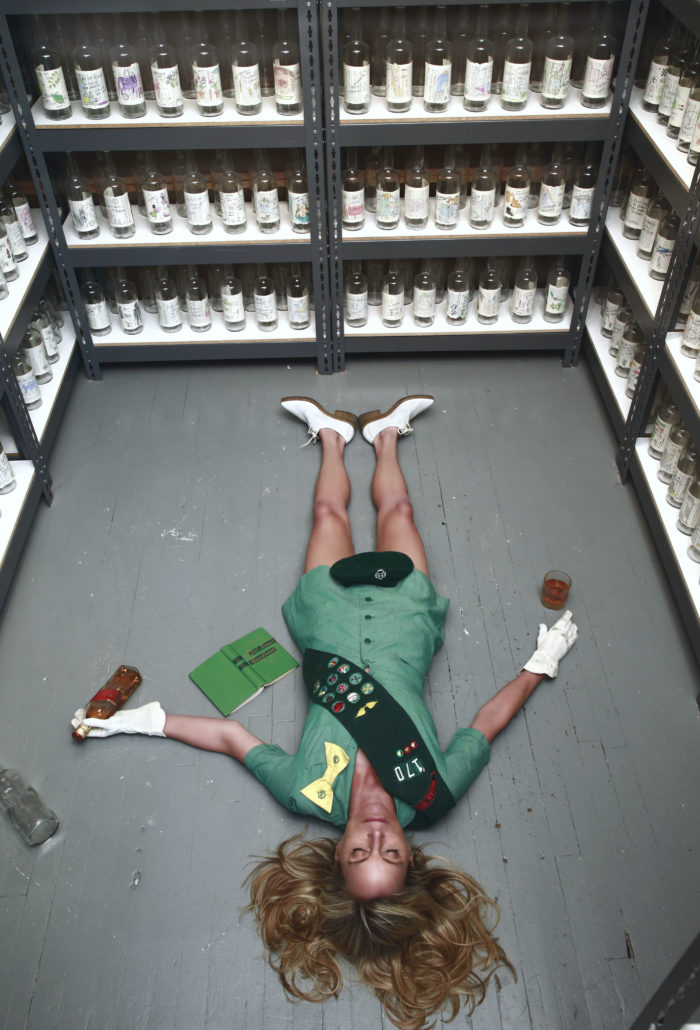
When I meet her at her Bushwick studio, Rachel Lee Hovnanian does not strike me as a rebel. Polite, easygoing, tastefully dressed, she seems like an adult version of the child she once was, a self- described “good girl” who obeyed the rules.
“Happy Hour,” the artist’s current show at Leila Heller Gallery in New York, is all about breaking them. Or at least breaking their spell. Hovnanian’s work in this and other shows casts her as a sort of anthropologist, examining the world of her childhood in the South—Houston to be exact—for clues as to how we live now.
Among the conventions she dispenses with is the notion that an artist should allow a decent interval, of a year or two, between gallery appearances. “Happy Hour” marks the second of three exhibitions in Hovnanian’s Woman’s Trilogy Project, which are running consecutively. She likens the experience “to watching Netflix. You could binge-watch all three shows without having to wait for ages.” She inaugurated the Trilogy with (Ray Lee Project Vol. 1) NDD Immersion Room, an immersive installation that addressed the title’s acronym, NDD, or Nature Deficit Disorder, in part by requiring visitors to surrender their phones and spend time alone in a reproduction of a crepuscular forest.
Hovnanian’s anthropology doesn’t attend solely to the rules by which we (women in particular) are meant to abide, but also to those addictions, habits and expectations that rule us. In Part I of the Trilogy, dependence on technology took center stage, yet the show also set out to confound expectations of gender. During an earlier exhibition, Hovnanian was told by a visitor that she was too feminine, too petite and blond, to produce the challenging work then on view. In response, she presented her next show, the “NDD Immersion Room,” under the persona of a male artist, Ray Lee.

With “Happy Hour,” she once again sets out to thwart gender stereotypes while considering the ramifications of addiction. In her studio, where the contents of the show were awaiting transfer, an enclosure of sorts—a house, a shelter—consisting of shelves filled with empty whiskey bottles, stood at the center. The bottles are labeled with pages torn from an old Girl Scouts Manual, to which Hovnanian has added childlike drawings and phrases like “She’s a slut,” “Gossip,” “Get in the car and drive away” and “Female Things?”
If the Girl Scouts Manual provides rules of conduct, the milieu in which the artist grew up enforced standards of decorum. Through the house installation, the show allows the grown artist to break the proper girl’s abetting code of silence by bringing to light her father’s alcoholism. “When you’re the child of an alcoholic, you only know your own experience; you don’t know that anyone else has those issues,” says Hovnanian. Barbed wire rimming the top of the enclosure reinforces her sense that, as she puts it, “I don’t want anyone in the house and I can’t get out of the house.”
Hovnanian is quick to point out that the stigmas associated with revealing one’s problems have not died out, they’ve only changed with technology. On social media, for instance, we tend to present versions of our lives no less idealized and sanitized than those she and others presented when Hovnanian was a child. I take the house installation as a portrayal of private life, the inner world; the artist turns to our exterior, social lives in a series of paintings that accompany the installation. All resemble schoolhouse blackboards, although they are grouped into pink canvases, blue canvases and a charcoal hue. (Ruled chalkboards are also found outside of the house installation.)
Like the show’s mournfully ironic title, the paintings’ lighthearted surfaces, alive with childlike drawings, give way to darker undercurrents: there are collaged photographs, Girl Scouts badges standing in for breasts and condoms, words such as “Help” and “I’m Fine” scrawled outside the lines. There are quotations, rendered squarely within the ruled lines, from the “Dick and Jane” book series. “I’m a severe dyslexic,” Hovnanian explains, “and I couldn’t read ‘Dick and Jane.’ The book was all about this white-picket-fence family, everything was perfect: Jane does what Mom does, Dick does what Dad does.”
Young women who stray beyond the lines—who fail to do what Mom does—are often publically shamed. Today, that might play out viciously on Twitter or Facebook. Decades ago, she would be saddled with a “questionable reputation,” as one pink canvas here puts it. Hovnanian recounts experiencing this firsthand: “When I was in high school, being the good girl, I had a date with some guy who told everybody that I had sex with him. I did not. It got passed around the school that I’d had sex with him, and then it got to the mothers, and then I got a questionable reputation.” The painting implicitly contrasts the shamed girl with the figure of the debutante, a Southern ideal. It’s a reputation questioned by the debutante’s attributes in the canvas, a monogrammed flask and a pearl necklace (which, the artist points out, has a double meaning: purity and a semen-spattered neck.)
The upstanding family driven by addiction, the good girl stained by a rumor, the debutante debauched: Hovnanian transforms her childhood story into an allegory of failed ideals, one that reflects our global, networked neighborhood as sharply as her own.










 in your life?
in your life?

